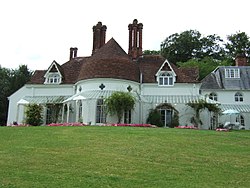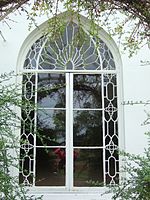Houghton Lodge
| Houghton Lodge | |
| Hampshire | |
|---|---|
 Houghton Lodge | |
| Location | |
| Grid reference: | SU34403311 |
| Location: | 51°5’47"N, 1°30’36"W |
| History | |
| Built 1790s | |
| For: | Barnard family by poss. John Plaw |
| Country house | |
| Cottage ornée | |
| Information | |
Houghton Lodge is remarkable house beside the River Test in Hampshire, built in the 1790s, probably intended as a fishing lodge. The architect is uncertain, but likely to have been John Plaw, a disciple of John Nash.[1] It is said to be the finest surviving example of a cottage ornée.
The house is a Grade II* listed building.[1]
The house

Many of the windows of the house are in the exaggerated, decorative Gothic, almost Levantine, style which originated from the Walpole's 'Strawberry Hill Gothic'. This playful, exaggerated decoration typifies the style in which the house was conceived. The architecture of Houghton Lodge marks a period of informality in British architecture which begin in the 1770s and lasted until the 1830s. The antecedents of Houghton's style of architecture, known as cottage ornée, can be traced to the 'Strawberry Hill Gothic' style made popular by Horace Walpole at his fantasy castle at Strawberry Hill in the final quarter of the eighteenth century and further popularised by the writings of James Malton in his 1802 Essay on British Cottage Architecture.[2]
Houghton was built when the country life was becoming fashionable for those who could afford it, from the improvement of roads and celebration of the rural idyll, which is reflected in the architecture of the country lodge, imitating the rustic (and hiding the servants' quarters). This aesthetic is encapsulated in the cottage ornée style of which Houghton Lodge is a fine example.
At Houghton, the principal reception rooms are placed on the ground floor, rather than on a piano nobile. The reception rooms, typical of the style, have french windows, shaded by a verandah, allowing immediate access to the garden.[1]
The grounds
The estate sits on the west side of the River Test, with watermeadows in the eastern part of the estate. An area of five acres of parks and lawns surround the house. A square planned grotto was built to the south-west of the house in the early 19th century. Its brick vault and walls are entirely lined with flint nodules and it has small haphazard turrets in each corner. The grotto received a separate grade II listing in 1986.[3]
The eighteenth century walled kitchen garden measures 310 feet by 215 feet, and is Grade II listed.[4] The walls are rendered chalk cob, with greenhouses built against the west wall.[5] A long herbaceous border flanks the exterior of the east wall. A topiary garden (known as the Peacock Garden) sits to the north of the house.
The estate has been owned by the Busk family since 1910.
The watermeadows are designated an 'Environmentally Sensitive Area' and are managed appropriately, without the use of any fertilisers, herbicides or pesticides. A 15-acre meadow walk has recently been developed here. The grounds are opened to visitors between 1 April and 30 September, but the house is only open by prior appointment to organised groups. There is an on-site tearoom and 6 units of tourist accommodation in a converted calf byre which opened in 2018.
On film and television
The house and grounds have been used as filming locations, for example:
- Wilde
- David Copperfield (1999 film)
- The Buccaneers
- Murder at the Vicarage.
Gallery
Outside links
References
- ↑ 1.0 1.1 1.2 National Heritage List 1093833: Hougyhton Lodge (Grade II* listing)
- ↑ Curl, p.206
- ↑ National Heritage List 1093834: Grotto doorway from road into garden south-west of Houghton Lodge (Grade II listing)
- ↑ National Heritage List 1301071: Walled garden north of Houghton Lodge (Grade II listing)
- ↑ Images of England retrieved 18 July 2008
- Girouard, Mark (1978). Life in the English Country House. Yale University Press. ISBN 0-300-02273-5. https://archive.org/details/lifeinenglishcou0000giro.
- Curl, James Stevens (2006). A Dictionary of Architecture and Landscape Architecture (Paperback) (Second ed.). Oxford University Press. ISBN 0-19-860678-8. https://archive.org/details/dictionaryofarch00curl_0.













